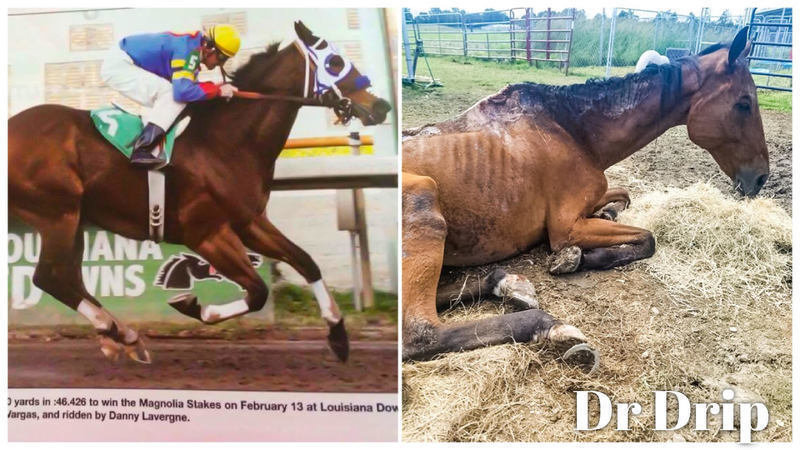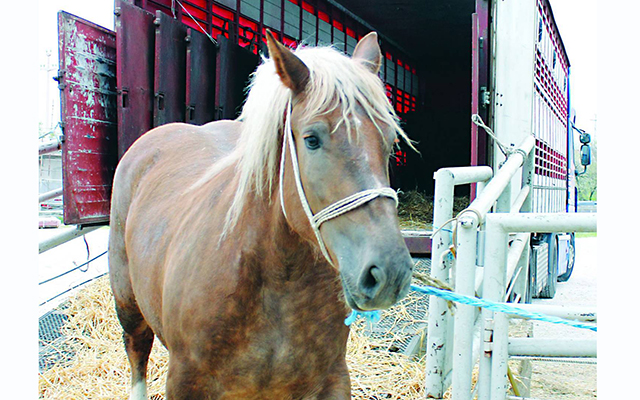The story of Dr Drip highlights what is wrong in the horseracing industry, write Lynley Tulloch and Sandra Kyle.

Dr Drip was an American multi-stakes winner, a racehorse with an impressive pedigree, bred for big things. During his career he earned a barrel of money for his owners but when he was no longer profitable they got rid of him. Many ex-racehorses go unceremoniously straight to slaughter at a fraction of their natural life span, but Dr Drip changed hands between owners until he ended up with Jermaine Dewayne Doucet Jr, an 18-year-old from an impoverished Louisiana community. The day he was discovered Dr Drip had no water and the pile of hay in his pen was molding and inedible. He was so weak and skinny that he didn’t even have the energy to swish the flies off his tail, and his underside was covered with maggot-infested sores. The ex-thoroughbred was too far gone to save, and was euthanised the next day.
Dr Drip had been a magnificent specimen in his prime, a perfect example of equine athleticism. Yet even though they are large, strong animals horses are very easily hurt, especially when they are being whipped to run at dangerously high speeds on hard ground.
That racing hurts horses should be obvious. Those who think a day at the races is harmless are either uninformed, or don’t care about horses. No doubt it’s great fun for people who attend race meets in their thousands, wearing slinky dresses and stiletto heels, derby hats and bow ties, and sipping champagne. It’s an opportunity to see and be seen, get a little tipsy, and if you’re lucky go home richer than you arrived. What’s wrong with that? What’s wrong with having a bit of fun?
There’s no problem with having fun so long as your fun does not hurt other beings. In horse racing as in so many other cases, we think nothing of exploiting animals for our benefit. Whipping a horse on to go at ever more dangerous speeds is just one example. Another, widespread in the industry, is to begin training horses at the age of just two years old when their bones have not stopped growing. Intensive training at this stage can cause tendons to break and bones to chip and fracture. Burst arteries is another injury that is more likely to happen to a juvenile horse. A number of racehorse deaths are caused by forcing a horse to perform on pre-existing injuries, which are not always obvious. Horses, like many animals, are very stoic. They could be in constant pain and you might not even know it. The problem of horse injuries and deaths is further complicated by the use of drugs . A racehorse who is laid off because of injuries is not profitable for the owners, so unscrupulous veterinarians and trainers administer drugs to mask the effects, resulting in the injury being aggravated and worsened.
International animal rights organisation, PETA claim that studies show one in 22 horses fail to finish a race due to injuries sustained and that three thoroughbreds die every day in North America from race injuries. In the past eighteen weeks, there have been 28 horse deaths at just one racetrack, Santa Anita Park in Los Angeles.
Like many other racehorses, so long as he was winning Dr Drip was safe, but the moment he started finishing further back in the field he wasn’t worth the effort, and was ‘retired’. We often talk about ‘retired race horses’, as if there is some form of animal retirement that compares to human retirement. There is not – it’s a disingenuous way of creating the illusion that the animals we selfishly use get some kind of deserved rest after their hard work.
Let’s set the record straight. A survey funded by the RSPCA in 2002-2003 in Australia found that standardbreds and thoroughbreds were exited from the industry for a range of reasons – including poor performance, ill-health or injury, or unsuitable temperament and breeding. The fate of many of these horses remains unknown due to no tracking system. Some get rehomed for other equestrian purposes while 6% of thoroughbreds and 17% of standardbreds get sent to the slaughter house.

Save Animals From Exploitation (SAFE) revealed that in New Zealand 1962 animals were slaughtered in 2011. That is a lot of individual horses for a small country with a small population. The problem is we don’t see them as individuals when they’re earmarked for slaughter, but as a statistic. We don’t look into their eyes and see the sadness, the terror. For horses bound for slaughter their trial begins on the truck, where they are sometimes transported for more than 24 hours at a time without food, water or rest. Such are the conditions of transport that horses are sometimes hurt or even killed in transit. By the time they arrive at the slaughterhouse they are exhausted, stressed, bewildered and fearful.
When it comes to a quick and painless death, it is harder to achieve with horses than it is for bovines, sheep, and other large mammals. Horses are skittish by nature (owing to their heightened fight-or-flight response), which makes accurate pre-slaughter stunning difficult. As a result, horses can sometimes remain conscious during dismemberment. Before the last domestic plant closed in 2007, the United States Department of Agriculture documented rampant cruelty violations and severe injuries to horses. Gail A Eisnitz, in her book ‘Slaughterhouse’ interviewed one horse slaughterhouse worker who said: “You move so fast you don’t have time to wait till a horse bleeds out. You skin him as he bleeds. Sometimes a horse’s nose is down in the blood, blowing bubbles, and he suffocates.”
It’s time to rethink our relationship to non-human animals and stop abusing and slaughtering them. If you are in doubt about whether we should treat an animal like a horse as a form of entertainment and profit, and then send it off to slaughter, then try putting your feet in the horse’s shoes.
Would you like this done to you?

